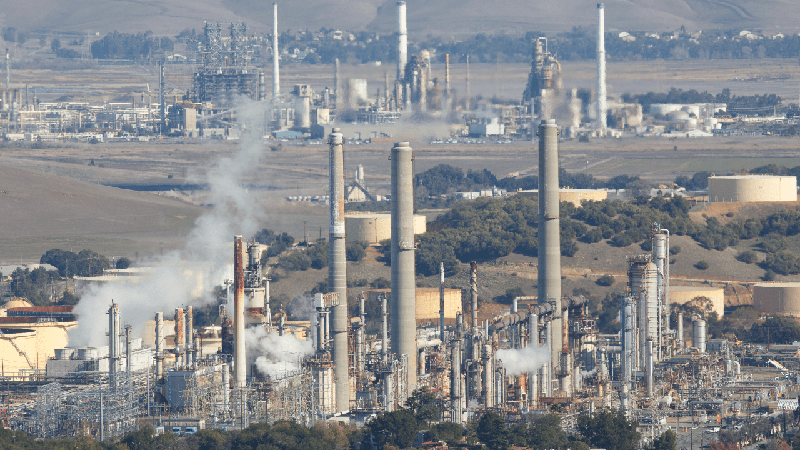
Gases being released at the Marathon oil refinery in Martinez. Under the state's new climate change plan, refineries would capture carbon emissions and inject them underground. Photo by CrystalMage, Shutterstock
By NADIA LOPEZ, CalMatters
The California Air Resources Board today unveiled a new version of its highly-anticipated strategy for battling climate change, setting more ambitious targets for cutting greenhouse gases and scaling up controversial projects that capture carbon.
If adopted by the air board at its Dec. 15 meeting, the plan would radically reshape California’s economy, alter how Californians’ vehicles, buildings and appliances are powered, and ultimately serve as a blueprint for other states and countries to follow.
“Failure is not an option,” said air board Chair Liane Randolph. “There is too much at stake and we need to move as fast and as far as we can to lessen the worst impacts of climate change and leave future generations a livable and healthy California.”
The five-year climate change strategy, called a scoping plan, outlines in its 297 pages how California could end its reliance on oil and also clean up the nation’s worst air pollution.
The staff’s final draft plan adds bolder commitments, reducing fossil fuel use by 94% from 2022 levels by 2045 — up from a goal of 91% in the September version of the plan.
The plan also sets a more aggressive goal of cutting carbon emissions 48% below 1990 levels by 2030 — up from the 40% by 2030 required under state law — until reaching net-zero emissions in 2045. (Net-zero or carbon neutrality means striking a balance between the carbon dioxide added to the air and the carbon that’s removed.)
California has a long way to go to meet the new 48% goal in just eight years. By 2020 it had cut emissions only about 14% below 1990 levels, according to air board officials.
Danny Cullenward, a climate economist who serves as an advisor to the state air board and Legislature, said California isn’t on track to meet its existing 2030 reduction target, much less the new, more stringent goal.
“I don’t want to say California isn’t doing anything on climate. We’ve done a lot of things,” he said Cullenward, who serves on the Independent Emissions Market Advisory Committee. “But this is such a superficial exercise and it’s filled with so many faults and errors.”
Air board officials, however, said they are confident that the state can achieve the new target, largely with new mandates and policies enacted this year. State officials phased out sales of new gas-powered cars by 2035, set a more stringent low-carbon fuel standard and streamlined siting and permitting of renewable energy projects.
“This plan is a comprehensive roadmap to achieve a pollution-free future,” Gov. Gavin Newsom said today in a statement. “It’s the most ambitious set of climate goals of any jurisdiction in the world, and it’ll spur an economic transformation akin to the industrial revolution.”
But Cullenward criticized the staff’s modeling, which is used to predict how each sector of the economy will reduce emissions. He said the plan lacks a thorough analysis of the feasibility of its projections and makes major assumptions.
One example, he said, is that the plan relies on other agencies, such as the California Energy Commission, setting new policies, but it doesn’t address the timing and roadblocks they may face or other details.
“It’s a pretty aspirational document but it's filled with bureaucratic doublespeak,” he said. “It's really frustrating because there's so much work to be done.”
ome policy experts say setting ambitious goals is a crucial step to cleaning up air pollution and combating climate change.
“The scoping plan can at least help us direct our attention even if it doesn’t give us as much detail as we want,” said Dave Weiskopf, senior policy advisor with NextGen Policy, a progressive advocacy group. “On the one hand that is really frustrating. On the other hand, it tells us that if we put in the effort to say what we think a good plan should look like, we at least have a shot of getting the state to take meaningful action.”
The plan relies on two advanced technologies for removing planet-warming carbon dioxide. Combined, 15% of all of the state's targeted greenhouse gas cuts will come from direct carbon removal and carbon capture and storage.
Read more ‘Slashing greenhouse gasses: California revises climate change strategy’ on CalMatters.